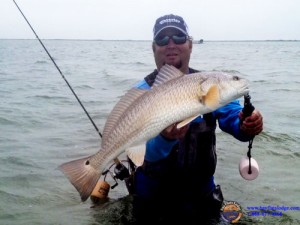One of the guides recently had an opportunity to fish with some very close friends of ours at the lodge that we hadn’t fished with in years. On the day they showed up at the Lodge, the wind was pumping out of the south at times in excess of 30-mph. There was a springtime cool front approaching over the course of the next day or two, but this was the only time we could all get our schedules together in order to all be in the same place at the same time, so they were going to make the best of whatever the weather was intending to throw our way. Everyone gathered out on the deck following dinner that evening to watch the disappearance of the sun below the evening’s horizon. As we took in the beauty to the day’s end, we sat discussing what the strategy would be for tomorrow’s outing. The guide told everyone that if we were trying to plan our trip based solely upon what the weather man was saying tonight, then we might as well get on a plane to Las Vegas because we would probably have better odds out there! Of course, he was just joking, but how many times have you found a Texas weather person to be absolutely correct in their forecast? The final input to the topic of tomorrow’s strategy was that we would simply need to find a place that would provide us with protection from the wind while, at the same time, offer us an ample amount of bait activity.
Everyone awoke the next morning to find that the wind had subsided substantially overnight. The wind was now blowing ever-so-slightly out of the southwest, so they wanted to take advantage of the moment by getting out on the water before the wind took a turn for the worse. They made the first stop of the morning along some exposed oyster beds that were silted with mud and sand in water that was anywhere from 1-foot to 6-feet in depth. The water around the reefs this morning was clean and green, and we just knew we were going to be in for a real treat atop the shell. As luck would have it, however, we were not into our wade for more than twenty minutes when the wind suddenly picked up abruptly and then switched and started blowing hard out of the north. It was so hard, in fact, that it literally only took a few moments to muddy the water where we had setup their first wade session over the shell. As frustrating as it was, it was still quite an impressive change to see take place so very quickly in front of our friends eyes. They packed up and headed across the water in search of wind protection and bait.
It was beginning to mist, which actually felt somewhat like sleet hitting your face while doing 40-mph across the bay in rough water. The weather was deteriorating, and so were their hopes of catching any mentionable fish today. I bet they spent the better part of two hours searching for a place that could give them wind cover that also showed all signs of active bait fish. The guide finally maneuvered his way to a shoreline that he had not fished for quite some years that offered a moderate bluff adjacent to the water itself that all but stopped the cold wind from blowing across the water. It was a tapering shoreline that dropped to seven or eight feet in depth within about forty to fifty yards off of the bank. The bottom consisted of mostly hard-packed sand with an occasional soft spot here and there. There were also brief humps of shell scattered haphazardly along the shoreline, both above and below the water line, and there were troughs situated in no specific pattern that mostly parallel to shore. But best of all, he witnessed mullet being chased to the surface every few minutes or so while they all stopped to examine the area before dropping anchor.
With the number of people they had fishing that morning, they were able to present a rather good selection of artificial baits to the fish. The crew had some top waters working, some slow-sinkers, some plastic paddle tails, and even one of the hard crank baits. I think everyone managed to catch fish on whatever they happened to be throwing, but the clear winning producer was the dark-colored suspending plastic bait’s. The fished really liked them!
I’m convinced that them finding active mullet that morning was the only reason everyone were successful in finding a bite in those conditions. Their results that morning after locating those active baitfish just further reiterates to all the importance of always looking for signs of fish, rather than just fishing a spot simply because you’ve previously caught fish there. Remember to practice CPR, “Catch, Photo, and Release”, whenever possible on trophy Trout and Reds…Guide Chris Martin, Port O’Connor/Seadrift region. www.BayFlatsLodge.com…1-888-677-4868.

